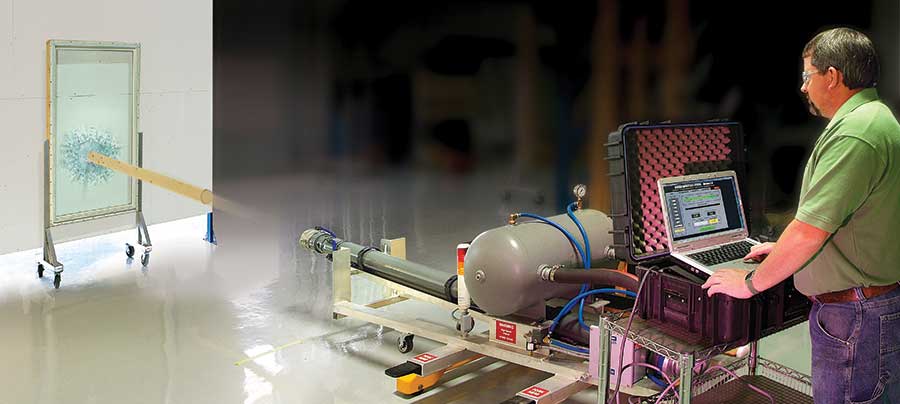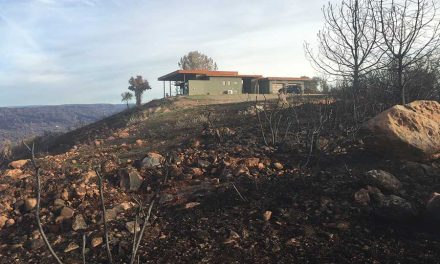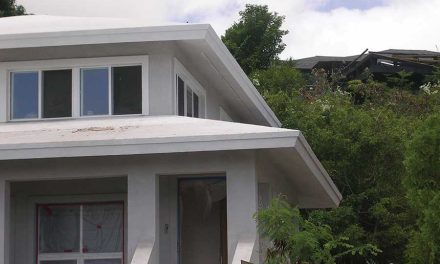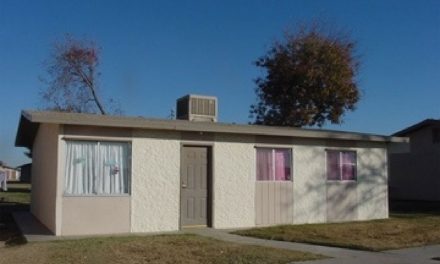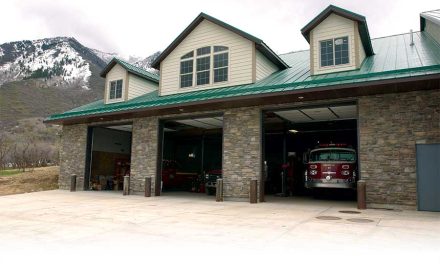Technician conducting an air-cannon test, which blasts an 8 foot 2×4 directly at a window at 35 miles per hour. Courtesy of Weather Shield Windows & Doors.
You build walls with the strength to stand up to wind storms and the impact resistance to stop flying debris cold. They are ideal for hurricane country. But wait—if you install ordinary windows, what good are the walls?
The disaster resistance of an ICF building is sharply diminished if it includes ordinary windows. The wind and projectiles are likely to shatter the glass, sending shards flying and allowing all sorts of further debris to enter.
But that’s not all. If the windows are out, air can blow inside freely. This “pressurizes” the interior, and that frequently leads to the roof popping off. With the roof gone, debris and water can rain in from above. In fact, insurance industry representatives claim that a lost roof often leads to so much damage that the house is declared a total loss. Even if the walls are left standing, for practical purposes the house is as good as destroyed. And it all starts with broken windows.
So if the concrete walls are to provide a real advantage in hurricanes, they need to be supported by equally tough windows.
Fortunately, such a beast is readily available. Bowing to both demand and strengthened codes, many manufacturers are now offering impact-resistant windows.
Impact-resistant windows are similar in design across manufacturers. In these windows, one of the panes of glass is actually a sandwich of two glass layers around a layer of tough plastic. The layer of plastic is called the “interlayer”. On impact the glass shatters, but the plastic generally stays intact. It may stretch, but it resists tearing, and the glass fragments tend to remain adhered to it. The window frame and hardware may also need to be reinforced so that they withstand impact, too.
Most windows rated for impact resistance are tested according to two ASTM standards, E1886 and E1996. This is in addition to the testing required of windows for air and water leakage and structural integrity. Under the ASTM impact resistance tests, a laboratory fires projectiles at the window glass, then applies air pressure to the window. The projectiles virtually always crack the glass, but the typical interlayer holds it in place. The air pressure is applied to one side and then the other in an alternating sequence that continues until pressure is applied to each side 4500 times.
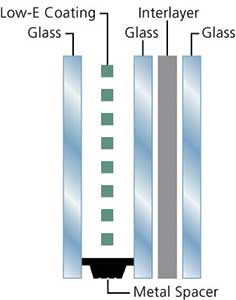
Side view of the layers of materials in a double-pane window with an impact-resistant interlayer. Courtesy of JELD-WEN Windows & Doors.
But not all tested windows are considered to have the same wind resistance. A wind speed map from ASCE (American Society of Civil Engineers) divides the U.S. into different “wind zones” according to how great the risk of high winds is considered to be in the area. ASTM identifies the zones by number, from 1 to 4, with 1 designating the lowest risk and 4 the highest. The standard also recognizes that different windows may be subject to greater wind forces depending on their position in the building and the surrounding landscape. This is called its “exposure.” In the testing it is possible to vary the weight and speed of the projectiles, as well as the level of air pressure applied. Depending on these factors, a window will be rated for a particular design pressure and zone. So, for example, a rating of “DP70 Zone 3” approves a window for use in any wind zone up to zone 3 requiring basic protection.
According to Travis Eisenbarth of Pella Corporation, “We test many of our impact-resistant windows to what ASTM calls the ‘Missile D, Windzone 4’ level, which approves them for use in any zone up to 4 in the basic protection level. It is usually associated with pretty high design pressures.”
The rules for whether a window has passed the testing at a given level are complex. But in most cases it has to survive all the projectiles and pressure cycling with very little tearing to the interlayer. For some of the higher levels of approval it must also still be “operable”—it must be possible to open and close the window so that it can serve as an emergency exit.
The ASTM testing standard is adopted by the International Residential Code and the International Building Code, which are used by most areas of the U.S. to govern residential construction. However, Miami, Dade, and Broward Counties of Florida have their own requirements. They specify results that can be a bit tougher to achieve than those in the ASTM standard, although the test methods used are very similar.
Most major manufacturers have at least one line of wind-resistant windows. Brian Hedlund, Product Manager of Vinyl Windows for Jeld-Wen says, “We call ours ImpactGuard Protection. It’s available as an optional feature in many wood, vinyl, and aluminum windows and patio doors. You basically pick the standard window you want and choose the optional feature of ImpactGuard protection which commonly includes laminated glass and structural reinforcement”.
The survival of the higher-rated windows has so far been reported to be good. After severe wind events they may have cracked glass that needs to be replaced, but the interlayer frequently survives and saves the house from the flying debris and changes in pressure that occur with a fully breached window.
Estimated costs vary, depending on a wide variety of factors. Some companies have estimated that the impact-resistant version of some of their windows can be as little as 15 percent more than the original. But in some situations the premium is estimated at as much as 100 percent.
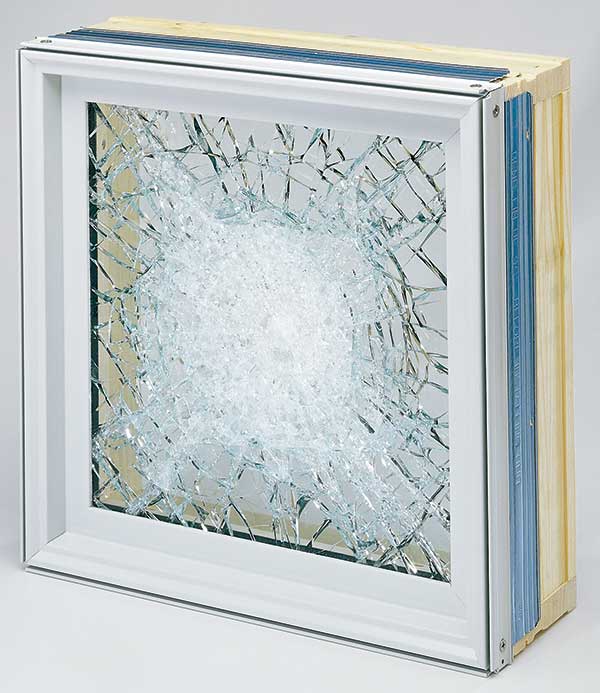
Impact-resistant window after sustaining the force of a nine-pound 2×4 shot at 34 miles per hour in testing. Courtesy of Pella Corporation.
Most wind-resistant windows have other advantages as well. For one, they can cut sound transmission from outside more than conventional windows. Laurie Reding of Marvin Windows notes that, “One of our conventional windows has an STC (sound transmission class) of 28. But the impact-resistant version of it has an STC of 33.” This increase of five points in the STC corresponds to a reduction in the sound transmission of nearly one-half.
The windows may also provide added security. According to Dave Koester of Weathershield, “ASTM has a test called the ‘Forced Entry Test’. It’s ASTM 588-85. Basically, it consists of a person hitting the window with a crowbar and trying to get through the glass in a given time. If he succeeds, the window fails, and if he fails, the window passes. Most impact-resistant windows pass it. They’re amazingly tough.” However, some manufacturers said they do not conduct the test or advertise the benefit because the test is imprecise and it is difficult to make specific claims. The test is not required by normal building codes.
Impact-resistant windows also permit less UV transmission. This may be of interest where sun coming in can bleach fabrics or damage contents. Says Reding, “Our standard double-pane, low-E window glazing stops about 84 percent of the ultraviolet rays from entering. But our StormPlus impact-resistant windows stop 99 percent.”
Popularity of impact-resistant windows is growing. According to Hedlund, “They’re primarily sold in hurricane-prone regions. They’re required in much of Florida and other areas in the Southeast. However, we’re seeing demand from Texas to Maine, as they go farther North up the East Coast and into the Gulf Coast as more and more codes are requiring them.” Polly Tousey, a Brand Manager at Pella Corporation says, “Public awareness has increased the demand for impact-resistant windows beyond coastal areas, since these products help protect homes and businesses whether the building is occupied or not. In addition, Pella’s impact-resistant windows and patio doors also help reduce sound, adding to their popularity in noisy or heavily-populated areas as well.”
Pieter VanderWerf is President of Building Works, Inc. He can be reached at pvander@buildingworks.com, and his company at www.buildingworks.com.
Pieter VanderWerf
President of Building Works, Inc. He can be reached at pvander@buildingworks.com, and his company at www.buildingworks.com.

